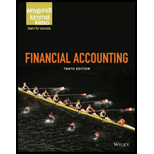
Concept explainers
(a)
Financial Statements: The statement prepared for the specific period which comprises the financial information of the organization. It includes a statement of income which shows the profitability of the business,
The financial statements include the following statements:
Income Statement: It can be known as “
Classified Balance Sheet: In case of the classified balance sheet, the assets are arranged in different classes in order to their liquidity and liabilities are arranged in order to their time of obligation. The classified balance sheet provides more useful information to the company as compared to the other form of the balance sheet.
Statement of
Cash flow statement: It is the statement which involves the outflows or inflows of cash in the organization which could be because of the investing, financing, and operating activities carried on by the organization.
Closing Entry is made at the end of the accounting period; in order to transfer the temporary balances of the income statement to the permanent accounts on balance sheet. The main objective of it is to make the balances of temporary account to zero.
Post-closing
T-account: It is the account or graphical representation of general ledger account or its entries. The left side of T-account is debit side and the right side represents as credit side. The
In order to journalize the transaction, the following are the rules which are to be followed:
Rules of debit and credit:
All the items mentioned in the income statement and balance sheet are presented by journalizing the accounts, then classifying them into ledgers and afterward resulted in the summarized income statement and balance sheet.
For journalizing the various accounts, rules of debit and credit has been followed according to the category of the account. There are five categories of accounts:
Assets: It can be defined as the resources which are controlled and owned by the organization and which are capable of providing some future benefits for operating the core business of the organization. Whenever any asset has been purchased or any transaction which increases the amount of asset, the asset account will be debited.
Liabilities: These are referred as Company’s financial obligation arising during the course of Business Cycle, which will be settled by the outflow of Resources. Whenever any transaction raises the amount of liability, the liability account will be credited.
Revenues: It is income that an entity earns from its normal business operations. It reflects the amount which is received by the firm by manufacturing or providing goods and services. Whenever income has been earned or due, the revenue account will be credited.
Expenses: These are the gross outflows incurred by a business entity while carrying out their regular business operations like manufacturing and providing goods and services. Whenever any expense has been due to be incurred, the expense account has been debited.
Capital account: This account represents the balance of amount invested by the stockholders. It also includes the earnings which are due and not withdrawn by the stockholders. Whenever any transaction increases the amount of capital, the capital account will be credited.
To prepare: The statement of income
(b)
To journalize: The closing entries for Company F for the year ended on December 31, 2019.
(c)
To prepare: T-accounts and income statement to
(d)
To prepare: Post-closing trial balance of Company F for the year ended on December 31, 2019.
Want to see the full answer?
Check out a sample textbook solution
Chapter 4 Solutions
Financial Accounting
- PQJ Company uses a job order costing system and has set a pre-determined overhead rate of 430% of direct labor cost. Job T-350 was charged with direct materials of $68,000 and with overhead of $77,400. Assume PQJ Company prices its jobs at 70% above manufacturing cost. Calculate the price charged to the customer for Job T-350.arrow_forward5 POINTarrow_forwardI need help with this general accounting question using the proper accounting approach.arrow_forward
- I need help with this general accounting question using the proper accounting approach.arrow_forwardPlease given correct answer for General accounting question I need step by step explanationarrow_forwardFelix Manufacturing, a producer of electronic components, purchases semiconductor materials on credit on March 5. It processes these materials to make circuit boards on March 12 and pays cash for the semiconductor materials on March 20. On April 8, it sells the circuit boards to an electronics retailer, and on April 25, it receives a cash payment for this sale. What is the length of the cash cycle in this case?arrow_forward
- I want to this question answer for General accounting question not need ai solutionarrow_forwardCan you explain the correct methodology to solve this general accounting problem?arrow_forwardUpon completing an aging analysis of accounts receivable, the accountant for Riverside Manufacturing estimated that $8,600 of the $124,000 accounts receivable balance would be uncollectible. The allowance for doubtful accounts had a $740 debit balance at year-end prior to adjustment. How much is the bad debt expense? a. $740 b.$7,860 c. $9,340 d. $8,600arrow_forward
- I need help finding the accurate solution to this general accounting problem with valid methods.arrow_forwardCan you explain the correct approach to solve this general accounting question?arrow_forwardPlease help me solve this general accounting question using the right accounting principles.arrow_forward

 AccountingAccountingISBN:9781337272094Author:WARREN, Carl S., Reeve, James M., Duchac, Jonathan E.Publisher:Cengage Learning,
AccountingAccountingISBN:9781337272094Author:WARREN, Carl S., Reeve, James M., Duchac, Jonathan E.Publisher:Cengage Learning, Accounting Information SystemsAccountingISBN:9781337619202Author:Hall, James A.Publisher:Cengage Learning,
Accounting Information SystemsAccountingISBN:9781337619202Author:Hall, James A.Publisher:Cengage Learning, Horngren's Cost Accounting: A Managerial Emphasis...AccountingISBN:9780134475585Author:Srikant M. Datar, Madhav V. RajanPublisher:PEARSON
Horngren's Cost Accounting: A Managerial Emphasis...AccountingISBN:9780134475585Author:Srikant M. Datar, Madhav V. RajanPublisher:PEARSON Intermediate AccountingAccountingISBN:9781259722660Author:J. David Spiceland, Mark W. Nelson, Wayne M ThomasPublisher:McGraw-Hill Education
Intermediate AccountingAccountingISBN:9781259722660Author:J. David Spiceland, Mark W. Nelson, Wayne M ThomasPublisher:McGraw-Hill Education Financial and Managerial AccountingAccountingISBN:9781259726705Author:John J Wild, Ken W. Shaw, Barbara Chiappetta Fundamental Accounting PrinciplesPublisher:McGraw-Hill Education
Financial and Managerial AccountingAccountingISBN:9781259726705Author:John J Wild, Ken W. Shaw, Barbara Chiappetta Fundamental Accounting PrinciplesPublisher:McGraw-Hill Education





